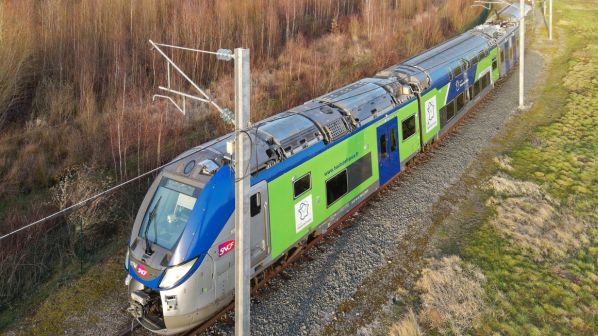FRENCH National Railways (SNCF), along with its partners Alstom, Bosch, Spirops, Thales and the Railenium Technology Research Institute, has begun tests with an autonomous regional mainline train, two-and-a-half years after the consortium to develop the train was launched.
A Regio 2N regional EMU was modified and equipped for the purpose of the trials at the start of the year at Alstom’s site in Crespin, formerly part of Bombardier. Various sensors, cameras as well as radar and lidar equipment was fitted to collect essential data for the project.
The first trials were conducted between Aulnoye and Busigny, and Busigny and Calais in the north of France during a week-long period at the beginning of March. During the trials, the Regio 2N regional train prototype ran on the commercial main line, with the project's engineers and technicians on board.
The trials included tests of the perception and recognition systems for the signals located along the track, and the geolocation system, which includes satellite technology and provides the precise position of the train.
During the first phase of trials, the sensors and equipment were activated to observe performance. They did not control over the movement of the train, which was driven by an SNCF driver specialised in operating under test conditions.
At the end of the week, trials were conducted at the CEF railway test centre in Petite-Forêt, near Valenciennes, to test the train’s autonomous operation system, which can automate the acceleration and braking of the train.
A second series of trials is taking place on the national rail network at Busigny from May 17 to 21 to fine-tune the train prototype’s operating system, which in the coming months will lead to lead to trials of semi-autonomous operation, including autonomous acceleration and braking under driver supervision.
The trials are a key step towards achieving the consortium’s ultimate objective of achieving full autonomy in train operation by 2023.
SNCF launched two projects in September 2018 to develop and integrate autonomous passenger and freight train prototypes for main line infrastructure at Grade of Automation (GoA) 4 within five years. The freight consortium successfully operated a locomotive at GoA 2 under real mainline operating conditions using ERTMS in December 2020.
The trials, authorised by the French National Railway Safety Authority (EPSF), will help to substantiate the safety demonstration required for the train’s future authorisation to place in service. As an observer in the project, EPSF will be in a position to assess the understanding of the technologies developed and their impact on the railway system, as well as any possible regulatory changes required for this new type of operation.
Cybersecurity has been taken into consideration from the start of the project; the project partners are working closely with the National Agency for the Security of Information Systems (ANSSI).
The Regio 2N regional train converted for the trials will be used as a prototype over the next two years in tests on the Aulnoye - Busigny line both during the school holidays and in regular passenger operation.
Outside of the research and test periods, the train will be in run in regular commercial service. During these commercial trips, in conventional driving mode, onboard systems will record data that will improve the performance of the signal recognition algorithms by detecting, for example, the colour of the traffic lights and the surrounding environment of the train.
At the same time, laboratory work is being carried out on trial simulators at the sites of each of the consortium partners to fine-tune the itineraries of the test train and to further develop the automated system.
SNCF says automation of the system will result in a number of benefits for passengers and customers, including:
increased capacity, as operating more trains makes it possible to transport more passengers and freight
greater fluidity and regularity thanks to harmonised traffic flow and optimised speed, making it easier to react to unforeseen circumstances, and
more environmentally friendly transport, thanks to reduced energy consumption and the shift from road to rail.
“Another step has been taken towards achieving autonomy in rail,” says Mr Pierre Izard, director of technology, innovation and group projects, SNCF Group. “The mobilisation of the SNCF teams and of our partners allows us to explore all the issues, both human and technological. With our research work and trials, we are making progress in the rail sector and preparing for its future development.”

